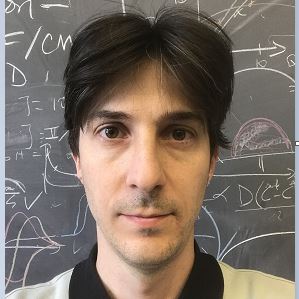Faculty & Staff

Renault, Christophe
Title/s: Assistant Professor
Specialty Area: Analytical Chemistry
Office #: FH-415
Phone: 773.508.3128
Email: crenault@luc.edu
Degrees
2008 M. S., Chemistry, University Paris 7, Denis Diderot (FR)
2011 PhD., Chemistry, University Paris 7, Denis Diderot (FR, Laboratory of Molecular Electrochmistry)
2012-2014 Postdoctoral Associate, University of Texas at Austin (Crooks Lab)
2014-2015 Postdoctoral Associate, University of Texas at Austin (Bard’s Lab)
2015-2016 Postdoctoral Associate, University of Twente (NL, Lemay’s Lab)
2016-2022 Researcher at CNRS/Ecole Polytechnique (France, LPMC)
2022-2023 Research Scholar at Purdue University (Dick’s Lab)
2023 Assistant Professor at Loyola University Chicago
Research Interests
The Renault group explores chemistry at interfaces. A wide variety of chemical events occurs at interfaces between solids and liquids. Molecules and particles in solution can interact with an interface leading to bond formation or breaking as well as transfer of particles like electrons and protons, for example. These interactions are ubiquitous in natural systems like cell membranes and play a critical role in human-made devices like batteries, sensors or catalyst. Understanding and analyzing surface interactions is bound to impact deeply humanity. The Renault Group acquired an exceptional expertise in electrochemistry, a field of science dedicated to the study of charge transfer through interfaces. We use this expertise to satisfy our scientific curiosity and push forward human knowledge.
The Renault Group is focusing on three research areas:
- Development of sensors and ultra-sensitive analytical methods. Analyzing our environment is the first step toward understanding and eventually controlling it. The recent introduction of perfluorinated molecules (e.g. Teflon) and nanoparticles in our environment poses a threat to our health. Their detection at the trace level represents a formidable challenge. To tackle this challenge, the Renault Group designs nanoprobes, chemically modified to recognize individual target molecules such as proteins and DNA strands. Detection of one molecule at a time is a game-changing approach bringing ultimate sensitivity. Taking advantage of that we aim at developing the field nano-analytical chemistry applied to biological and artificial targets.
- Understanding interfacial physico-chemical processes. Efficient design of new technologies relies on a permanent feedback between experiment and theory. This is why understanding physico-chemical processes at an interface is an important activity of the Renault Group. Advanced microscopic and macroscopic models are used to describe a wealth of phenomena encountered at solid|liquid interfaces: charge transfer kinetics, coupled-interfacial and homogeneous reactions, multi-steps reactions (mechanistic study), mass-transport by diffusion/ migration/convection and surface adsorption. Complex systems involving peculiar geometries or coupled physics are simulated with COMSOL Multiphysics©, a powerful finite-element modelling software. Armed with this powerful tool we solve scientific questions in a quantitative and predictive manner.
- Fabricating probes and instruments beyond the state-of-the-art. Provide boats to humanity and humans will explore new continents, provide rockets to humanity and humans will explore new planets! Exploring the frontiers of scientific knowledge is often bound to the available instrumentation. The Renault Group takes a pro-active stance by developing state-of-the-art instruments and probes to answer unique scientific questions. Micro- and nano-fabrication of electrodes as well as original coupling of electrochemical measurements with optical microscopy are at the heart of our technical expertise.
Selected Publications
Pendergast A.; Deng Z.; Maroun F.; Dick J.E.; Renault C. “Revealing Dynamic Rotation of Single Graphene Nanoplatelets on Electrified Microinterface” ACS Nano, 15, 1, 2021, 15, 1, 1250–1258.
Deng Z.; Renault C. Unravelling the last milliseconds of an individual graphene nanoplatelet before impact with a Pt surface by bipolar electrochemist” Chemical Science, 2021, 12, 12494-12500.
Glasscott M.W.; Pendergast A. D.; Goines S.; Bishop A. R.; Hoang A.T.; Renault C; Dick J. E. “Electrosynthesis of high-entropy metallic glass nanoparticles for designer, multi-functional electrocatalysis” Nature Commun., 2019, 10, 1-8.
Deng Z.; Elattar R.; Maroun F.; Renault C. “In situ measurement of the size distribution and concentration of insulating particles by electrochemical collision on hemispherical ultramicroelectrodes” Anal Chem, 2018, 90, 12923-12929.
Kim, J.; Renault, C.; Nioradze, N.; Arroyo-Currás, N.; Leonard, K.; Bard, A. J. “Electrocatalytic Activity of Individual Pt Nanoparticles Studied by Nanoscale Scanning Electrochemical Microscopy” J. Am. Chem. Soc., 2016, 138, 8560–8568.
Dick, J. E.; Renault, C.; Kim, B.-K.; Bard, A. J. “Simultaneous Detection of Single Attoliter Droplet Collisions by Electrochemical and Electrogenerated Chemiluminescent Responses” Angew. Chem. Int. Ed. 2014, 53, 11859-11862.
Renault, C.; Anderson, M. J.; Crooks, R. M. “Electrochemistry in Hollow-Channel Paper Analytical Devices” J. Am. Chem. Soc. 2014, 136, 4616-4623.
Renault, C.; Andrieux C. P.; Tucker, R. T.; Brett, M. J.; Balland, V.; Limoges, B. “Unraveling the Mechanism of Catalytic Reduction of O2 by Microperoxidase-11 Adsorbed within a Transparent 3D-Nanoporous ITO Film” J. Am. Chem. Soc. 2012, 134, 6834-6845.


